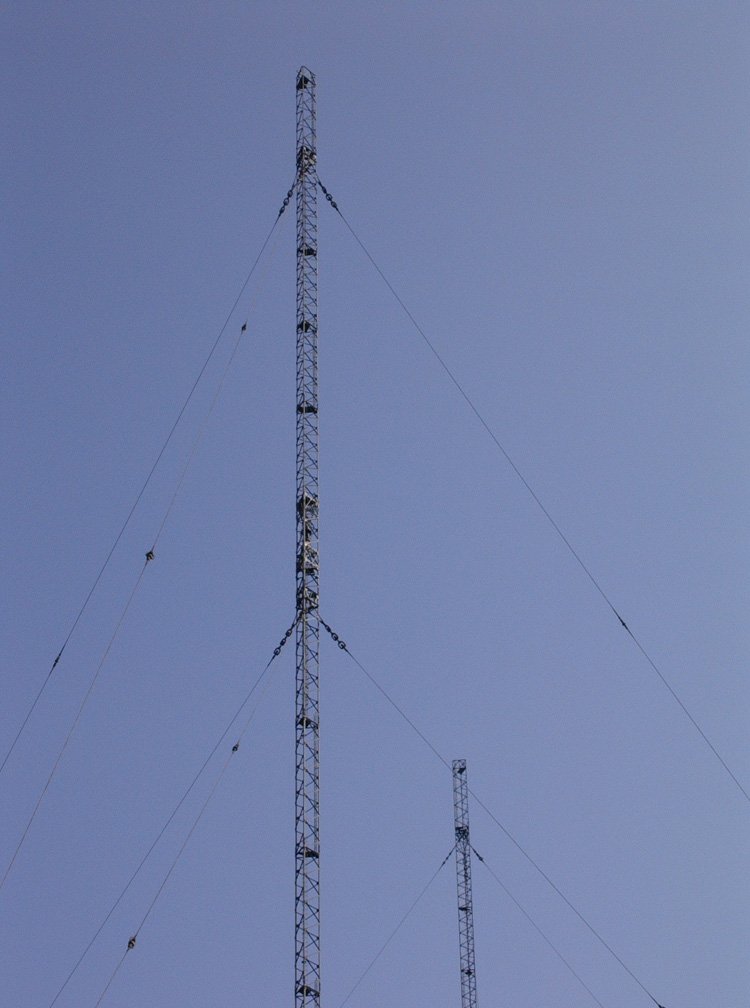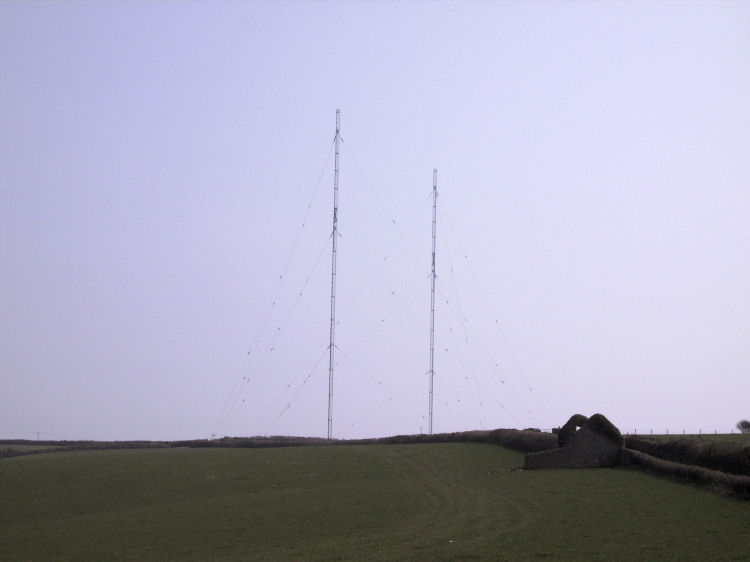 |
UK Broadcast Transmission |
|
|||||||||||
THE TRANSMISSION GALLERY
START POINT
| Photos by Mike Smith and David Neale | Page last updated: 2025-12-07 |
| Start Point was the last high power Medium Wave site to be built by the BBC before the outbreak of the war, entering service on 14th June 1939. It took over 1050 kHz from Washford, which up until then had been broadcasting both the Welsh and West Regional programmes on separate wavelengths, but for which latter service Washford wasn't the ideal site to cover the whole of the south west. A station at Clevedon also entered service at the same time on 1474 kHz to serve the Bristol area and Somerset, with Bournemouth 6BM and Plymouth 5PY both closing. Two masts were built, the northern one being energised and the southern one acting as a reflector to reduce spillage out into the English Channel. Both had break insulators installed so that the site could operate as an anti-fade radiator. However just three months later - on the outbreak of war - Start Point was closed down and listeners were forced, ironically, to retune to much weaker signals from Washford for the Home Service. Almost immediately however, tests were undertaken at Start Point to explore the possibility of using horizontal polarisation at the site, in the hope that horizontal polarisation would deny enemy bombers any direction finding information from a single transmitter which wasn't part of an SFN (single frequency network). The tests were successful and Start Point started broadcasting the new Forces Programme on 877 kHz to the Allied Expeditionary Force in France. After the fall of France Start Point was redeployed back to 1050 kHz and broadcast the European Service; this role continued until May 1944 when the transmitter was shut down to allow work to convert it for a new job, namely to transmit the Allied Expeditionary Forces Programme to the troops engaged in the Normandy landings. This involved swapping the electrical deployment of the masts so that the southern one was energised and the northern one became the reflector. The new programme duly began two days after D Day on 1050 kHz, but plans were already afoot to move the transmission to a completely new frequency of 583 kHz, "lent" to Britain by the French government-in-exile and allotted to one of their North African dominions. 583 kHz (with its excellent ground wave characteristics) continued carrying this Forces programme until the end of the war. In addition a second transmitter was installed early in the war, which was used (mainly on short wave) to back up reception of the Home Service. At this point (1945) both Pawley and Wikipedia (which uses Pawley as a source) let us down. Pawley states that Start Point was moved to 977 kHz in July 1945 in order to carry the Home Service. However, in actual fact the transmitter remained exactly where it was on 583 kHz; the only change was that the Allied Expeditionary Forces Programme was replaced by the Home Service (West Region) in July 1945, when the new peace-time broadcasting framework was put in place; (977 kHz was in fact deployed from this date at very high power for the European Service from Ottringham.) Radio dials from receivers of the era confirm that Start Point broadcast the Home on 583 kHz. However, this use of 583 kHz at Start Point DID come to an end in September 1946 when Ottringham surrendered 977 kHz and moved back to Long Wave, Start Point took over 977 kHz for the Home and 583 kHz was thus released in time for Droitwich to start testing on that frequency in preparation for the arrival of the Third Programme a month later. In March 1950 Start Point moved once again, coming home to rest on almost the exact frequency for which it had been designed eleven years previously, namely 1052 kHz. And there it stayed throughout all the subsequent wavelength changes, although the Home Service became Radio 4 in 1967 and in 1978 1053 kHz was redesignated to carry Radio 1. Pawley tells us that in 1957 both masts were replaced, although the new ones were again equipped with break insulators. However subsequently - probably in the 1960s - the break insulators were latticed over, as had happened at Daventry-Dodford for the Third Programme mast. From 22-Sep-1980 Start Point acquired an additional MW transmitter when the initial post-1978 wavelength-change arrangements for Radio 2 (which hadn't involved Start Point) were modified, and a new 50 kW transmission of Radio 2 began from there on 693 kHz; (related changes involved the Radio 2 relay at Exeter moving from 693 kHz to 909 kHz, with the Plymouth and Torbay Radio 2 MW relays closing.) |

| When Radio 1 MW was closed the transmissions on 1053 kHz at Start Point finally fell silent, as the new INR station decided to go back to the set-up the BBC had originally deployed for Radio 2 just after 23rd November 1978, (ie relays at Exeter and Plymouth rather than a high power transmission from Start Point). 693 kHz continues though, broadcasting Radio 5. |



| Below: David took these pictures of Start Point back in April (2007) with a lovely sunset behind them... |



Clevedon | Daventry | Droitwich | Ottringham | Washford MF
Tricks of the Trade - Combining Two Services at Start Point
BBC RD South Devon site testing (1935)
BBC RD: South Devon site testing (1936)
Description of the Installation and its Deployment 1939 - 1945
| |
Back to TX Gallery index | TX main index
|